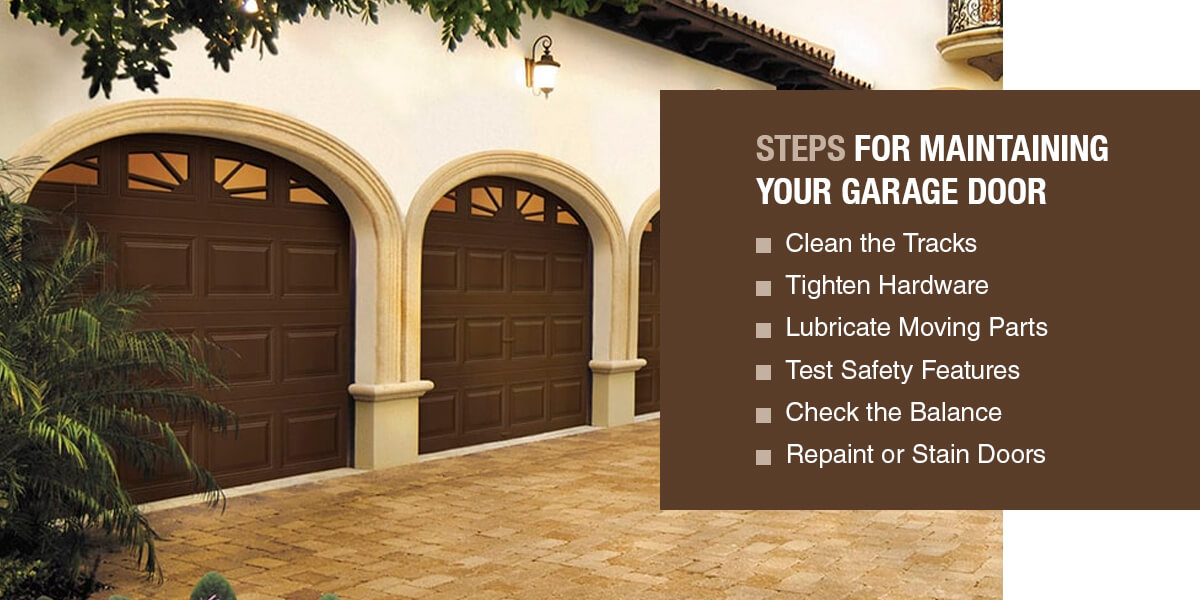Garage Door Maintenance Checklist
A quick review of your garage door's components can be a great way to ensure your door continues to operate consistently. Review these areas at least annually and as often as every three months:
Steps for Maintaining Your Garage Door
Here are six steps you can take to maintain your garage door.
Clean the Tracks
Over time, dirt, debris and rust can build up in your garage door's tracks. This build-up can prevent your garage door from working correctly and cause problems. Use a small brush to clean the tracks and parts carefully, then gently wipe them down with a damp cloth.
Tighten Hardware
As you use your garage door over and over, the vibration of the door can loosen the components. Use a wrench, socket or screwdriver to tighten loose brackets, bolts and screws. Be careful not to overtighten the hardware — overtightening can cause stripping or damage to the door parts. If you come across any smaller rusted or damaged parts, you can replace them.
Lubricate Moving Parts
Lubricate door hinges, rollers (except nylon rollers), sheave bearings, torsion springs and the lift cables at the bottom corners of the door annually with Clopay Pro-Lube. Lubricant allows door hardware to work smoothly and correctly. Improperly lubricated components can stick and prevent the door from working. Garage door lubrication is essential to avoiding damage, wear and loud noises. You can purchase Clopay Pro-Lube from your Clopay® Dealer or at The Home Depot.
Test Safety Features
While performing your garage door maintenance, always test the safety features. Checking these features keeps you and your family safe from accidents and injury when using the garage door. Automatic doors typically come with pressure sensors and auto-reverse, which prevent the door from closing on an object in the garage door's path.
To test the pressure sensor and auto-reverse, have the garage door close on a small plank of wood or solid object. When the door touches the object, it should reverse and open. If it fails to reverse after touching the object, have a professional inspect and repair or replace your pressure sensor to prevent accidents.
You'll need a long object like a broom to test the photoelectric sensor. Begin automatically closing the garage door, then wave the broom underneath the closing door. If the sensor is working correctly, the door should reverse. If it doesn't, the sensor isn't responding correctly and will need a professional inspection.
Check the Balance
The spring tension affects the door balance. Tension that is too low or too high makes your opener work harder, straining the system and leading to unnecessary wear and tear. To test the balance, pull the opener's automatic release handle and lift the door until it's halfway open. Balanced doors will stay open halfway, but unbalanced doors will close or open themselves. Don't attempt to fix the balance yourself — call a professional to get your balance corrected.
Repaint or Stain Doors
Wood garage doors will need to be checked yearly for cracking, peeling paint or fading. Wood garage doors must be painted or stained on all sides before installation and refinished every few years, depending on your area's exposure and weather conditions. Unless you want to change the color, steel, composite or aluminum garage doors do not need to be repainted. Painting instructions specific to your door model can be found in your owner's manual.

VIEW CLOPAY OWNER'S MANUALS